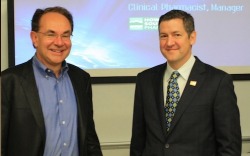The business of pharmacy

Innovation to improve health care is at the top of many practitioners’ list.
For John Shaske (who recently spoke to students, faculty and staff in the School of Pharmacy about running a profitable pharmacy in times in expanded scope), operating a cost-effective pharmacy is all about improving the lives of patients and contributing to a more efficient, better-resourced health care system.
Mr. Shaske is the owner and operator of Howe Sound Pharmacy in Gibson, British Columbia. The pharmacy offers a wide range of health care products and services, including health and lifestyle consultations, compounding, long term care, drug disposal, drug interaction counseling and more.
Their business model operates in a three-tier organization.
“At the intake station the pharmacist consults with the patient to complete a comprehensive assessment which solves all drug-related problems.” Mr. Shaske explained.
“Then the first station is where regular prescriptions are filled, station two does all the more complex, overflow, or third party prescriptions that need to be adapted. They also order and receive stock, do compounding and other work around the dispensary. The third station does data entry where the documentation is put into the computer but fills prescriptions when the second station is busy.”
The model saves tremendous human and financial resources, which impacts all other areas of health care while improving patients’ medication related outcomes.
The Canadian Foundation for Pharmacy awarded the University of British Columbia and Howe Sound Pharmacy a $35,000 grant in 2013, to conduct the PhInDMORE study, which allowed investigators to review pharmacist interventions and their clinical and economic impacts on patient outcomes and the health care system. .
Amongst the study’s most interesting outcomes was that out of 4000 patient encounters in the pharmacy, an estimated 2505 trips to a doctor’s office were avoided, 13 visits to an emergency room, and 10 visits to a hospital.
“One of those that avoided doctor’s office visits possibly also prevented kidney failure due to incorrect usage of ibuprofen – the patient was taking it in copious amounts, mistakenly thinking kidney pain would be a warning if there was a problem. If he hadn’t visited us, he may have eventually progressed to dialysis, as when we intervened there was kidney damage already. The potential cost savings in this one individual case could amount to substantial costs over a lifetime,” Mr. Shaske revealed.
Pharmacists are able to charge fees to provincial government of British Columbia for performing services such as medication reviews, immunizations, drug counseling – to name a few.
“By having licensed pharmacy technicians do what they’re licensed for, which is checking the prescriptions and ensuring all the rules and regulations are followed, and by having pharmacy assistants perform all administrative work, pharmacists are able to focus entirely on the identification and solving of drug therapy problems, writing up care plans, and communicating with other stakeholders. The accuracy of prescription checking and the increased quality of filing has increased greatly since those duties have been taken over from the pharmacists. This in turn has allowed pharmacists to focus 100% on (improving) patient outcomes.”
Dr. Carlo Marra, Dean (School of Pharmacy), advocates that the role the community pharmacy plays in the application of medication management on intake, avoiding drug therapy problems, and associated health issues is an important component of the interdisciplinary health care team.
“Right now there isn’t really a business model like this for pharmacies in this province, but the potential is there,” he said. “The benefits for health care practitioners in all disciplines, for the government in saving costs and maximizing resources, and most importantly, to patients and the quality of health care they receive, are just too enormous to not consider adopting a similar model in Newfoundland and Labrador.”